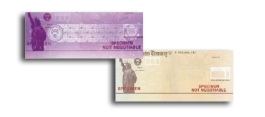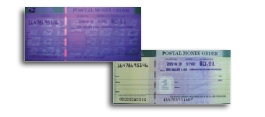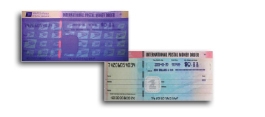|
Distribution of Proceeds
By Lisa A. Tyler
National Escrow Administrator
How do you "undo" a prohibited payment made at closing? Specifically, a disbursement made against the closing instructions provided by the lender? Read "Distribution of Proceeds" to learn how one escrow officer learned a valuable lesson about making distributions to unrelated parties in a sales transaction involving divorced sellers.
It is our duty to protect the Company from fraud and forgery and the only way to uphold that duty is to equip our offices with fraud fighting tools. In this issue read "Fraud Fighter Quick Tips" to discover the new ways the UV-16 Fraud Fighter device can help save your office from accepting counterfeit treasury checks and money orders.
The Company implements its policies and procedures through the issuance of Technical Memoranda and the eScrow eManual. Typically, these items are distributed as a direct result of the latest issues and trends in our industry. But we don't stop there! At our live training events, we elaborate on these policies and procedures by sharing with you the very latest "behind the scenes" stories that led to such policies and procedures. Lastly, we publish these stories in an effort to "get the word out." Often we receive submissions from settlement employees asking us to share with you the lessons they have learned so you too don't have to learn the hard way. The article entitled "Divorce Breeds Nasty Desire" is a perfect example of such a story.
This month's Fraud Insights is already packed full of information, so what else could possibly be learned? When you read "Distribution of Proceeds" and "Divorce Breeds Nasty Desire," you will learn we are only human and we all make mistakes, but how we recover from those mistakes is the real test. In these stories there was no time to waste and the faster the settlement agent responded and worked on the issues, the better the outcome for our Company. In both of those instances, as well as many other stories not published here, it took several levels of management involvement and teamwork to come to a resolution. If you do make a mistake, immediately bring it to the attention of your management so you can formulate a plan in an effort to lessen the risk and loss to the Company.
|
|
|

|
|
Distribution of Proceeds
Failing to heed the warnings contained in escrow technical memoranda and reiterated at our live training events, an escrow officer followed the seller's written assignment of proceeds to unrelated parties. Only after the funding and disbursement of the proceeds did the buyer's lender point out the language in the instructions prohibiting those disbursements and demanded the escrow officer "undo" the transaction.
In a recent sale transaction, the sellers were in the middle of a divorce. Their divorce decree called for the payment of outstanding debt and the balance to be split between the former spouses, as follows:
| Reimbursement for misc. items to Michael Stephens | $4,000 |
| Pay off prescription drugs to Chimes Pharmacy, Inc. | $2,000 |
| Pay off car loan to Independent Factory Automotive | $3,000 |
| Pay off personal loan to AmeriCredit | $3,500 |
| Pay off personal loan to The Best Service Company | $3,400 |
Then, prior to closing the sellers request, the following additional disbursement from proceeds:
| Payoff personal loan to Jim Maher | $41,000 |
The escrow officer proceeded with closing the transaction and sent only the buyer's half of the settlement statement to the lender prior to funding. The lender funded the transaction and then demanded both sides of the HUD as a post-closing condition, the escrow officer disbursed her file and sent out a final HUD to all parties, including both sides of the HUD, to the new lender.
The funding lender noticed the multiple disbursements to unrelated parties on the HUD and demanded the loan funds back, pointing out the following language contained in their loan instructions:
Disbursements shown on the seller side of the HUD-1 that are non-lien related or not part of normal closing costs must be approved in writing by lender prior to the disbursement of funds.
The escrow officer sent a copy of the seller's divorce decree authorizing the majority of the unrelated disbursements. Because the disbursements were made pursuant to a divorce decree, the lender allowed all but the $41,000 to remain on the settlement statement. The lender demanded the payee bring the money back and it be disbursed to the seller as proceeds, or the title company would have to buy back the loan.
Unfortunately, the check to the unrelated party had already been cashed, so placing a "stop payment" was not an option. The escrow officer scrambled to recover the monies. She contacted the listing agent to let him know the money would have to be returned. The listing agent told the sellers to let the title company "eat it," meaning make the title company buy back the loan for not following the lender's instructions.
In the meantime, the lender contacted the mortgage broker to make him aware of the situation and to alert him that if the money was not returned to the escrow agent, funded to the seller as proceeds and a new HUD-1 settlement statement produced, the lender would no longer allow the mortgage broker to sell their loans. The broker was furious because he had developed a great working relationship with this lender that was able to consistently fund his loans.
It was the mortgage broker who intervened and with the assistance of the escrow officer convinced the unrelated party to return the funds to the escrow holder. Once the funds were returned they were promptly disbursed to the seller and the settlement statement was amended to show the new disbursement.
Since mortgage fraud is most commonly detected through disbursements of proceeds to unrelated parties, a lender's closing instructions contain provisions which prohibit the assignment of proceeds. Their instructions extend to legitimate assignment of proceeds, such as those called for in the following examples:
- Distributions called for in a divorce decree
- Distributions to an accommodator in a 1031 exchange
- Distributions to another title company or even another file for another transaction
Don't get caught in the mess the escrow officer in this story suffered. She had to put other transactions on hold to resolve the issues caused by not following the lender's instructions, disappointing not only the parties to the subject transaction, but others as well.
Lessons Learned
- Always follow the lender's instructions. If the lender prohibits payments from the seller's proceeds, then let the principals know you will not be able to honor the request for additional services.
- As the escrow holder, our Company is not a party to a divorce decree. The lender easily rejected the other disbursements to unrelated parties based on their instructions. The divorce decree is for the former spouses to carry out, not the escrow holder.
- As the escrow holder, we have a fiduciary duty to the new lender. Always provide the new lender with a full HUD-1 showing both borrower and seller sides completed.
- Our dormant funds balances that are eventually escheated to individual states have substantially accrued as a result of making disbursements to unrelated parties in a transaction. You can do your part to reduce the amount of post-closing work our offices have to perform by refusing to pay unrelated parties in your transaction.
- If a principal requests these types of disbursements, it is best to say it is against Company policy.
- It is the settlement agent's fiduciary duty to remain neutral and safeguard the funds on deposit.
|
|
Fraud Fighter Quick Tips
As an update to an article we published last year, we have new tips on how to fully utilize the Fraud Fighter UV-16 to prevent our offices from accepting fake identification cards and counterfeit checks and money orders.
In our September 2008 issue we talked about a great tool to help stop fraud in our offices. We introduced the Fraud Fighter UV-16 and described the ways it has saved many of our offices from fraudulent transactions. Since that issue came out, two more states (Nevada and Virginia) have added UV features on their new drivers licenses.
Nevada: The current license reveals a repeating state seal when under UV light.
Virginia: The current license reveals the state seal with the Department of Motor Vehicles logo and text when under UV ink.
There are many features the device performs of which you might not be aware. For instance, it has a counterfeit detection UV light to catch counterfeit treasury checks and money orders. Following is what you will be able to see when using this tool.
 |
| U.S. Treasury Check: Glowing pattern |
| |
 |
| U.S. Postal Money Order 2009: Dashed pink line |
| |
 |
| International Money Order 2009: Dashed pink line |
| |
 |
| Western Union Money Order: Fluorescent thread pattern embedded in paper |
| |
There is one final bonus to using the UV-16 Fraud Fighter – it also works on immigration cards! Passports, Consular Cards and Resident Alien Green Cards include hidden security features that can be verified using the Fraud Fighter Detector.
As mentioned previously, the safety of our employees is our utmost concern. Now that settlement agents have learned how to detect fraudulent identifications, what should they do once discovered? First and foremost, do not cause a confrontation – you do not know the level of criminal you are dealing with!
If a fake I.D. is detected, go back to the customer and explain how all I.D.'s are verified by referring to the Fraud Fighter UV-16 and I.D. Checking Guides. Review the validation paragraph which describes the hidden image. Take them to the Fraud Fighter machine and show them their I.D. is missing the described image. Then explain the I.D. they presented does not contain the elements required in order to notarize their signatures and they will have to leave.
What does not occur in the above scenario? Accusations! Give the I.D. back to the customer. The safety and security of our settlement agents is far more important than keeping the fake I.D. If someone is willing to commit forgery, what else might they do? The above is a very non-confrontational way to excuse someone from your office. Some offices even report that they have put the Fraud Fighter machine in their conference room. Once the machine's function is explained to potential borrowers, some turn around and leave without even sitting down.
Contact UVeritech to obtain your own Fraud Fighter Machine by visiting www.fraudfighter.com or by calling 800.883.8822. And do not forget to ask for the special FNF rate!
|
|
Divorce Breeds Nasty Desire
A closer accepted wire instructions and acted on them, not realizing they were only signed by one seller – not both. The soon-to-be ex-husband then stole all of the equity out of his wife's and his former residence with one simple wire transfer instruction.
Our Company handled a recent closing with divorcing sellers who had relocated to Massachusetts from Texas. The sellers signed their closing documents remotely. Included in the package of documents were instructions on where to wire the proceeds from the sale. After the closing our office received a letter from the wife stating the following:
I am currently in the process of a divorce from Joe Bernard and in the legal requirement of obtaining records for the divorce settlement I have found out a wire transfer of $68,376.41 went into Joe's private account.
Joe (my soon-to-be ex-husband) told me the proceeds went to pay the existing loan on our home in Massachusetts. Your Company's failure to have the Wire Transfer Instructions document signed by me, one of the sellers, makes your company liable for my loss of the equity.
Joe deceived me; had I been aware the money was wired to him I would have known the money was not applied to our note as he said. The account you wired the money to is in Joe's name only. He deceived your Company, but I did not. Since I was not aware of the money going to Joe's account and I did not sign the wire transfer notifying me where the money was going, I am filing a claim for my half of the $68,000. Please accept this claim for $34,000.
After you settle my claim, you can pursue your loss from Joe Bernard. I have a 12-year-old daughter that I have to care for and this money is important to me.
The evidence attached to the claim letter and later verified through the escrow file deemed her claim valid. The wire instruction reflected an account in the name of Joe Bernard, but not his wife, and was only signed by Joe. The claims department verified the account holder's name with the bank as only Joe Bernard. The department then deemed the loss an escrow loss, which costs the operation dollar-for-dollar until funds can be redeemed from Joe Bernard.
Moral of the Story
The closer used the Wire Transfer Instruction as described in the March 2009 edition of Fraud Insights. However, the closer's acceptance of an instruction signed by only one principal ended up costing the operation $34,000. There is no doubt the Company will recover the loss amount, minus cost of legal action. Regardless, it is still a lesson hard learned.
|
|
